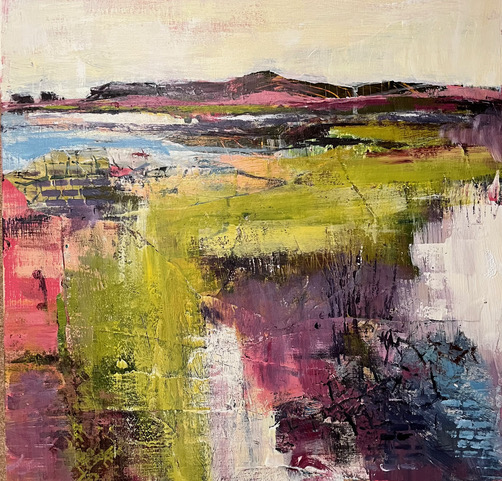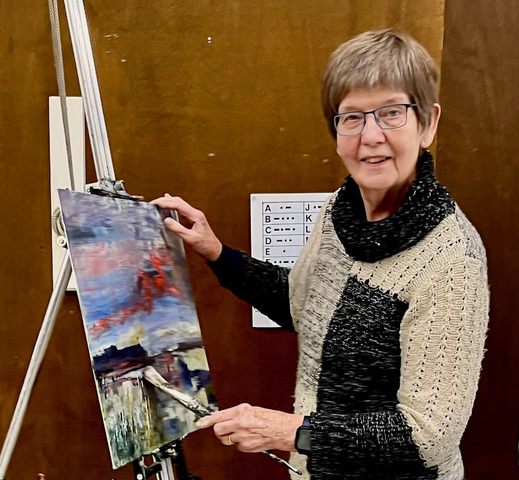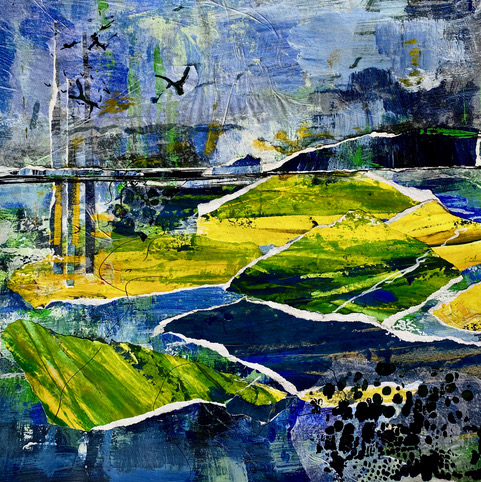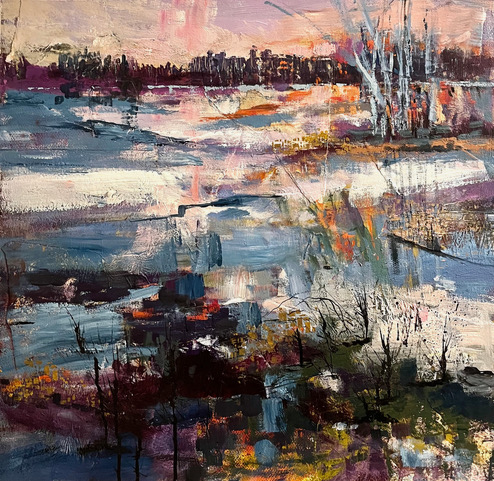
JULIA LEE BARCLAY-MORTON – YOGA, WATER AND REWRITING AUTISM
I interviewed writer Julia Lee Barclay-Morton about her experience of autism. Julia began as an experimental dramatist in New York, moving to the UK to


I interviewed abstract artist Karen Martin about how she discovered the joys of experimental art. Karen describes her work as: “…influenced by found materials, collage, mark making and alternative methods of working, inspired by sketching and use of scenery both local and on location.” Karen is former midwife who practises yoga, loves walking in the countryside and is a person of faith.
Leslie: What were the signs as you grew up and during your midwife career that art was an alternative vocation for you?
Karen: As far as I was concerned, I didn’t have any thoughts that art would eventually be my path. I knew I had an 1800C grandfather who was an artist/astronomer, and exhibited in the great exhibition at Earls Court in 1851 (Henry Blunt) My dad and other family members enjoyed using their hands to make things, including marquetry, and weaving, etc.
From a young age I used to enjoy making my own clothes, decorating, cooking etc. I also had a fascination for tools and used to go into hardware stores and look at all the different types available. My mother came from the island of Fyn in Denmark and I had wonderful holidays exploring each summer in the forest and beaches around this area. However, I had one major obstacle to overcome and that was an experience I had at the age of 7yrs which I now believe directed my early years.

I spent three months in The Queen Victoria Hospital, East Grinsted plastic surgery unit for the removal of a tumour on my thigh. (Congenital melanoma naevus.) The hospital had been used during the war for pilots shot down and badly burnt. Plastic surgery was new and at the experimental stage and pilots suffering burns (especially facial burns) would have skin grafts never tried before. (The Guinee Pig Club was formed to support these pilots under the New Zealand surgeon Sir Archibald McIndoe who was knighted for his services to the RAF. I had the privilege to meet him and remember him.)
The NHS was founded in 1948 and was in its infancy when I was taken there and I spent three months on an adult ward where I had many skin grafts and also had to learn to walk again. (The children’s ward was closed and had become an operating theatre during the war, and remained like this for some time after it ended). I was allowed visits twice a week for one/two hour (normal in those days!!) from my parents and witnessed many things, but also lots of kindness, especially from those who had suffered the most. When I eventually returned home, I knew I was set on becoming a nurse and although my education had suffered during this time, I went on to become a registered nurse and them qualified as a midwife.
After getting married and having my son I continued as a midwife until I took early retirement. We would occasionally go to art exhibitions, but life was mainly busy with work and keeping the home going. Unfortunately, my husband died shortly after retirement and my life was set to make major changes.
Leslie: Can you tell the story, please, of how you grew as an artist and how you developed the various techniques you use. What have you learned about yourself during that process?
Karen: Towards the end of my working life, I did have an urge to look at art and joined an evening class for beginners in watercolours. I realized this was fun and after all the stress of work I could unwind and enjoy the process. I lived near Amersham Art College and decided I wanted to sign on for some more serious art courses.
Art is definitely a step-by-step process especially at the beginning. It’s like a toddler learning to walk – unless it learns how to put a foot forward, she/he won’t be able to learn to balance and go on to run. And I was definitely up for it. I was actually learning to have fun!
All this learning the basics takes time. We would do a mixture of life drawing, still life, observational exercises such as drawing the anatomy of the skull, observing the landscape around us, and trying out different techniques in drawing and painting from photos. It was all good grounding for future use, but also needed to be revisited over and over again to let it sink in, digest and allow my art process and skills to grow.

Being with other artists was also very positive in gaining knowledge and ideas which we would bounce off each other. When I went to art exhibitions what I learned from the masters was eye-wateringly good and I had my favourite artists that I would enjoy revisiting over and over again. I also studied the history of art as a side line while at college in the evenings.
A few of my favourite artists included Peter Doig, Anselm Kiefer, David Tress, and John Piper to name a few.
Working as a midwife was about continuous learning to keep up to date, and this definitely rubbed off into my art. We had to learn to be prepared for many and any eventualities. It was hard work and full on, often going home late into the evening and returning early the next day. This habit is difficult to break and, to this day, I believe we need to always be prepared to learn new ways and keep an open mind as to possibilities.
I had also decided quite early on during my 4 years at the collage that I didn’t want to go down the route of formal training with a diploma or degree in art. I had come out of a stressful career and didn’t feel the need to enter a further one at this stage. As It’s proved to me much later and also now, I wouldn’t have gained anything from this.My desire to move forward and learn was better spent pursuing a path that was right for me.
I was extremely lucky to then be invited to join a weekly class where we had great fun experimenting with many different techniques. Almost nothing was forbidden! Throwing paint around, mark-making, printmaking, layering, collaging, burning, staining, there didn’t seem an end to how to make art happen. It was all just so invigorating, exciting, and I’d even say, I was learning to be a child again.
My son met and is now married to Scandinavian from the lake district area of Sweden and it has been a great privilege to be regularly transported back once more to the beauty of the forests life and I know this has had a huge influence on my art on many occasions.
Leslie: What are the mental disciplines you practise to maintain your best self as an artist? What activities/routines/habits/rituals help you to stay creative?
Karen: I believe in order to progress you have to learn to play and not be afraid to make mistakes. Mistakes can be a good thing; you can learn from this in many ways. As I was once told, for every ten paintings you produce, you can only expect one to be successful if lucky. But learning to fail is a skill you have to be prepared for, I believe. Failure, means growth, wisdom, maturity, knowledge, and another leg of the journey of art and life.
Regular courses in different ways of making art expanded my mind, and this often formed the basis of trips away and a holiday with other artists, including the UK, but also abroad, including Zambia, Greenland, Sweden, Sicily, Ithaca, Majorca, Lake Garda, to name a few.
I’ve been practicing daily yoga for many years, and am also a walker, and belong to a regular walking group which is a great way to get out and clear the mind.
I believe its vital to keep my mental side in good order, and regularly attend a Sunday morning service at my local church and for quite a while I enjoyed being part and helper of a youth group, which was great fun. It helps to keep me feeling young and so enjoy what teenagers get up to and learn from them.
I’ve found that regular life / portrait drawing, plus plein-air sketching helps with hand eye coordination, and I’ve practiced these skills all the way through in one form or another.
Whilst at collage I also looked at printmaking. This is a subject with many different techniques, some of which I enjoyed using, and some I experimented and then moved on. This is a real discipline of its own making and I regularly attend a printing studio where I continue with my way of experimenting. I’m pretty bad at producing an exact limited-edition set of prints partly because I want to be able to try out colours, style, and a whole range of different techniques before I am satisfied with a result. I work alongside a group of printmakers to produce a theme of work each year based on an author. This year we have just completed a group exhibition based on the writings of Laurie Lee. Previously this would have included John Betjeman, Virginia Woolf, Graham Greene, Roald Dahl, etc.
Leslie: Tell us about being a community artist and an experimentalist. Do the two ever clash? What have been the most interesting reactions to your art?
Karen: A thought provoking question! It’s basically taken me all my art career to admit I’m an experimentalist although I didn’t want to! I’m constantly wanting to try new approaches and admit I’ve have had some quite interesting reactions on occasions from other artists. Lockdown was a real revelation for me. I suddenly found that there was nobody saying to me that this or that was wrong! I joined classes online and leant how to experiment freely. It was an incredible experience and one I wouldn’t want to have missed. It was driving me forward in a way I had never expected, and believe it gave me confidence in my work I’d previously hadn’t felt.

Breaking into abstraction was interesting. When you look at a piece of art work the eye is naturally drawn to look for something familiar and its quite difficult to produce it without the constant battle between abstraction and realism. But battle I did and I’ve learnt and developed from this approach.
If I’m asked whether abstraction conflicts with community acceptance from people who say, “I don’t understand it,” my answer is no. My circle of art friendships with likeminded people is strong. It’s all about circles within circles. I believe we are each accepted for who we are and what our practice revolves around. Each is an individual with a unique handwriting skill of their own. I know I’ve been told that many times, that my work is recognised by the way I make it and worked on it.!! But as I‘ve mentioned before this all takes time and we are all on a journey. Some further along the road than others.
Leslie: Can you give examples of ‘mistakes’ you made and how they helped you on your artistic journey?
Karen: Mistakes!! I’ve made more than I can remember. There’s a saying I like and use if I think I’m having any form of success: “Take success and failure and treat them both the same.” This calms my mind down and stops any form of inflated ideas. What goes up must come down and it always does.
We can all make genuine mistakes. I was thankfully able to recognise this when I was accepted for the Royal Academy Summer Exhibition in 2019. A truly amazing experience, which I shall never forget. Incidentally, the accepted piece was influenced by my Scandinavian connections.
Most of my work these days uses multi layering with often quite a degree of collaging. I can apply a brush stroke and think, why did I do this, it looks wrong? But I can come back to it later and take another look, and realise the mistake was actually another step in my learning. I can revisit art work, and completely remake it, or use it as a base for a further piece of work.
To me, making art is not about just repetitive art making, which would soon dry me up. It’s about trying a new way of doing something and also using all the knowledge and skills I have already acquired to put back into the work. It does mean my art is not consistent, which can have its disadvantages.
Art is also not all together about selling, If it was I am already on a looser! However, when I do sell a piece that I know has my history embedded into it, it can feel good but also can be a wrench if I had struggled with it.
Leslie: How does the joy of creating art compare to the joy of being a midwife? What are the necessary difficulties to overcome and the emotional rewards for both? What skills and personal qualities developed in your first career have been of use in your second career?
Karen: This is another very interesting question. For quite a long time, while I was developing my art skills, I would have said there was no connection. Yet, there most definitely are!
Working in a professional occupation such as a midwife comes with responsibilities. The continuous learning process is long and can be quite arduous, and you had to be prepared for the unexpected to come through the door. Shift work was tiring, especially night duty, and if we were busy, we could work all night with barely a cup of coffee! But the rewards were immense on many occasions when a birth went forward well and a happy mother took her new born infant home for the first time. I spent very little time on the community but preferred the discipline of a labour ward. It was challenging learning and as we progressed in our profession as midwives, we learnt to take on new skills
Has this rubbed off onto me as an artist? I now recognise this as definitely yes.
There are times in my art when I can loosely apply a layer of paint and I can never get the end result right. On other occasions I can do this and look at the piece and think, how did I do this, its finished!! Is this inbuilt or has this been learnt, Or both maybe? Was this always going to be my journey? It was never by my design, so can I assume this was waiting to happen at some stage in my life?
I knew when I went into art, it was as if a lid had been lifted off my brain which I would find very difficult to ever close again. Had it been supressed when I was young? What has been extraordinary was my recent invitation to exhibit my work at Stoke Mandeville Hospital, where I was given my own private guided tour of the new midwifery unit. This came via my webpage for which I am so grateful to my webmaster to help me develop.
Next week I interview Linda Newbery, winner of the 2006 Costa Children’s Book Prize
ABOUT LESLIE TATE’S BOOKS:

I interviewed writer Julia Lee Barclay-Morton about her experience of autism. Julia began as an experimental dramatist in New York, moving to the UK to

I interviewed Gillean McDougall from Glasgow, who edited the collaborative projects Honest Error (on Charles Rennie Mackintosh and his wife Margaret Macdonald) and Writing the

I interviewed French writer Delphine de Vigan, whose book, No et moi, won the prestigious Prix des libraires. Other books of hers have won a clutch

I interviewed Joanne Limburg whose poetry collection Feminismo was shortlisted for the Forward Prize for Best First Collection; another collection, Paraphernalia, was a Poetry Book Society Recommendation. Joanne

I interviewed Katherine Magnoli about The Adventures of KatGirl, her book about a wheelchair heroine, and Katherine’s journey from low self-esteem into authorial/radio success and
| Cookie | Duration | Description |
|---|---|---|
| cookielawinfo-checkbox-analytics | 11 months | This cookie is set by GDPR Cookie Consent plugin. The cookie is used to store the user consent for the cookies in the category "Analytics". |
| cookielawinfo-checkbox-functional | 11 months | The cookie is set by GDPR cookie consent to record the user consent for the cookies in the category "Functional". |
| cookielawinfo-checkbox-necessary | 11 months | This cookie is set by GDPR Cookie Consent plugin. The cookies is used to store the user consent for the cookies in the category "Necessary". |
| cookielawinfo-checkbox-others | 11 months | This cookie is set by GDPR Cookie Consent plugin. The cookie is used to store the user consent for the cookies in the category "Other. |
| cookielawinfo-checkbox-performance | 11 months | This cookie is set by GDPR Cookie Consent plugin. The cookie is used to store the user consent for the cookies in the category "Performance". |
| viewed_cookie_policy | 11 months | The cookie is set by the GDPR Cookie Consent plugin and is used to store whether or not user has consented to the use of cookies. It does not store any personal data. |